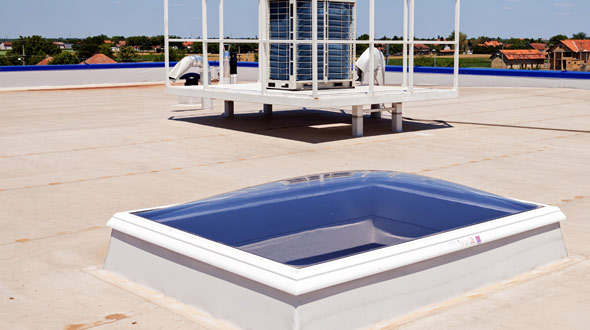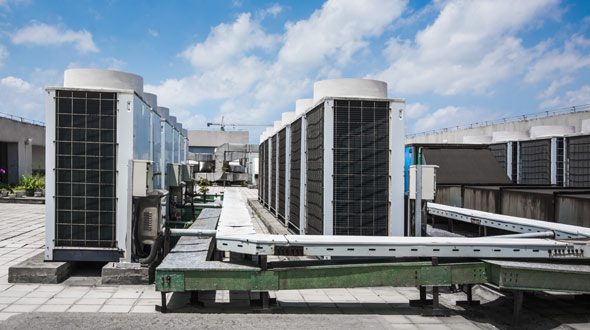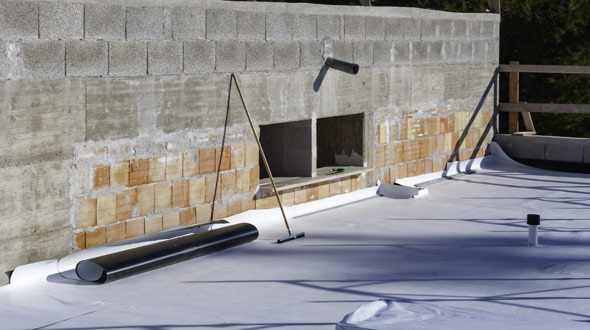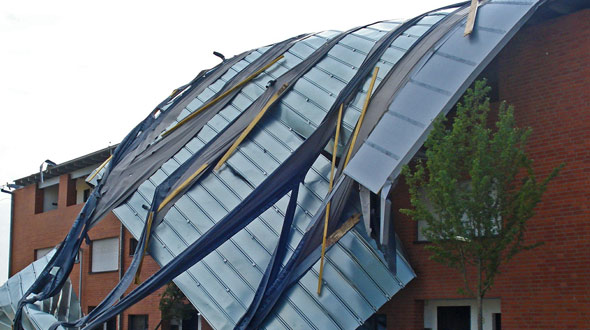
Not knowing the proper solutions to these common roof issues will leave you at the mercy of a roofer, and out of a lot a money.
Commercial roofing is susceptible to the elements, harsh weather, and many forms of damage. By taking measures to fix and prevent that damage, you can dramatically extend the life of your roofing system.
atlantacommercialroofingcontractors.com gathered information about 5 common commercial roofing problems, their solutions, and how to prevent them.
#1 Commercial Roofing Problem – Leaks
Leaking roofing systems are among the most common complaints industry-wide. Until it rains, most building owners don’t even realize there’s a problem.
While each and every problem listed in this article would likely result in leaks, the principal cause of leaks is often poorly installed flashing and pitch pans.
Flashing – This is a waterproof layer of material that keeps water from leaking into your roofing system at joints, vents, or appliance connection points.
Pitch Pans – These are used as sealants around rooftop penetrations and pipes protruding through a roof, and may not be properly sealed.

Solution: Locate the defective flashing or pitch pan and have them repaired by your roofing maintenance provider, or reputable commercial roofing contractor.
While this problem may be an isolated occurrence, have the rest of the roof inspected for signs of embrittlement, damage, or poor installation of its flashing, seams, and pitch pans.
Read more about the types and purpose of commercial roof flashing at atlantacommercialroofingcontractors.com/types-purpose-flashing/
#2 Commercial Roofing Problem – Scrapes, Punctures, and Holes
Scrapes, punctures, and large holes can be caused by foot traffic, storm debris, and wildlife. This type of damage can go unnoticed and build up over the years, affecting the support structure of the roofing system; left untreated, this leads to rot, mold, and a potential roof system failure.
This type of damage can also result in the voiding of manufacturers and maintenance warranties.
Solution: Install raised pathways or walk pads to and from equipment, vents, or frequently visited areas of the roof. If this type of pathway is not viable, have the roofing system reinforced in these areas to accommodate the increased traffic.

Have the roof inspected after any maintenance, severe storm or other activity which may lead to scrapes, punctures, and holes.
When being repaired, expansion and contraction of the roofing material and underlaying insulation must be taken into account to avoid further damage and future membrane tears.
#3 Commercial Roofing Problem – Poor Installation
The poor installation of your roofing system can lead to a myriad of problems. Everything from leaks, to complete failure is possible when your contractor neglects necessary, procedures, manufacturers guidelines, and quality control checks.

Solution: Do your homework. Check references, visit previous roof installations, read online reviews, and verify the company’s legal licensing and ability to work in your city.
If your roof was poorly installed, have the roof inspected and all discrepancies documented. The roofing company can then be held accountable for the correction, repair, or replacement of the faulty work.
Read about some common mistakes that most roofers won’t tell you about by visiting atlantacommercialroofingcontractors.com/15-mistakes-roofers-wont-tell-you/
#4 Commercial Roofing Problem – Shrinkage
In locations where temperatures frequently soar and plunge, the material and components of your roofing system may contract and later expand. Shrinkage can cause cracking, tearing, and the pulling apart of seams, membranes, and essential elements like flashing.
While all roofing systems are susceptible to shrinkage, TPO, EPDM, and PVC membrane systems are particularly vulnerable.

Solution: Have your roof inspected frequently to detect potential problems with shrinkage early on. Allowing this problem to persist will result in more expensive repairs, if not the replacement of the entire roof.
#5 Commercial Roofing Problem – Wind Uplift
Wind uplift can be devastating to materials and the integrity of a property. An uplift force is upward pressure applied to a structure that has the potential to raise it. Wind uplift occurs when the air pressure under a roof is greater than the air pressure above it.
When your roof is susceptible to wind uplift, there are two potential outcomes you may experience during severe weather conditions:
Partial Roof Removal – This occurs when a small portion of the roof is removed by sustained winds, and would only need to be repaired rather than replaced.
Complete Roof Removal – This outcome is usually associated with tornadoes and hurricanes. It is the near complete or complete removal of your roofing system, requiring the installation of a new roofing system.

Susceptibility to uplift is greater in roofing systems with poorly sealed seams and flashing. Another factor is the height of the building; ground wind speeds are typically much lower than those at higher altitudes.
Solution: Have a seamless or fully adhered roofing system installed. For existing systems, have all seams and flashing inspected and resealed if they show any signs of wind penetration.
Commercial Roofing Damage Prevention
The prevention of damage to your roofing system relies partly on the attention you give it. A maintenance plan and regular inspections are preemptive measures that will save you substantially.
Besides an annual inspection, a reputable contractor should be called to evaluate your roof after the following:
• Severe weather, including hail storms, tornadoes, hurricanes, and sustained high winds.
• Tree or branches falling on the roof or slamming into the building.
• Heavy debris blown onto the roof.
• Any time the structure suffers a significant jolt, including vehicle collisions and earthquakes.
If you do not possess a maintenance contract or plan for your roofing system, it is highly recommended to acquire one before your roof sustains irreversible damage.
Protect your Commercial Roofing System
You can extend the life of your roofing system and protect the significant investment it represents by taking simple measures to ensure its durability and stop minor problems from becoming major expenses.
In this article, you discovered essential information about 5 of the most common commercial roofing problems, how to solve them, and how to prevent them.
Your failure to keep a roofing maintenance contract or disregard for annual and emergency inspections could result in the failure of your roofing system, interruption of your business activities, and major financial losses that could be prevented.
Sources:
http://rci-online.org/wp-content/uploads/2014-CTS-chamberlain.pdf
https://www.nachi.org/epdm.htm